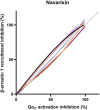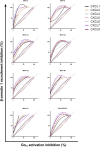Biased antagonism of a series of bicyclic CXCR2 intracellular allosteric modulators
- PMID: 40727104
- PMCID: PMC12301332
- DOI: 10.3389/fphar.2025.1631129
Biased antagonism of a series of bicyclic CXCR2 intracellular allosteric modulators
Abstract
Targeting the human chemokine receptor (CXCR2) holds significant potential in treating inflammatory diseases and cancer. In this study, we investigate the biased properties of previously reported CXCR2 antagonists (i.e., the MVH compounds). These antagonists likely bind to a conserved intracellular pocket that is also targeted by the well-known CXCR2 antagonist, navarixin. However, unlike navarixin, the MVH compounds are derived from a completely distinct chemotype, raising the possibility that they may engage the receptor differently and produce biased inhibition of downstream signaling pathways. To deduce these potential biased properties, the compounds were investigated using two NanoBRET-based assays, showing a preferential inhibition of CXCR2-mediated β-arrestin recruitment over G protein activation. Furthermore, a detailed statistical analysis revealed an additional bias in the inhibition profiles dependent on the specific ELR+ chemokine used to stimulate the receptor. Altogether, these results describe the MVH compounds as the first set of biased CXCR2 intracellular antagonists.
Keywords: CXCR2; G protein; G protein-coupled receptor; NanoBRET; antagonist; bias.
Copyright © 2025 Van Bosstraeten, Boon, Van Hoof, Dehaen, Szpakowska, Chevigné, Schols, De Jonghe and Van Loy.
Conflict of interest statement
The authors declare that the research was conducted in the absence of any commercial or financial relationships that could be construed as a potential conflict of interest.
Figures



Similar articles
-
The Black Book of Psychotropic Dosing and Monitoring.Psychopharmacol Bull. 2024 Jul 8;54(3):8-59. Psychopharmacol Bull. 2024. PMID: 38993656 Free PMC article. Review.
-
Drugs for preventing postoperative nausea and vomiting in adults after general anaesthesia: a network meta-analysis.Cochrane Database Syst Rev. 2020 Oct 19;10(10):CD012859. doi: 10.1002/14651858.CD012859.pub2. Cochrane Database Syst Rev. 2020. PMID: 33075160 Free PMC article.
-
Brexanolone, zuranolone and related neurosteroid GABAA receptor positive allosteric modulators for postnatal depression.Cochrane Database Syst Rev. 2025 Jun 26;6(6):CD014624. doi: 10.1002/14651858.CD014624.pub2. Cochrane Database Syst Rev. 2025. PMID: 40562419 Free PMC article. Review.
-
Omega-3 fatty acids for depression in adults.Cochrane Database Syst Rev. 2015 Nov 5;2015(11):CD004692. doi: 10.1002/14651858.CD004692.pub4. Cochrane Database Syst Rev. 2015. Update in: Cochrane Database Syst Rev. 2021 Nov 24;11:CD004692. doi: 10.1002/14651858.CD004692.pub5. PMID: 26537796 Free PMC article. Updated.
-
Interventions targeted at women to encourage the uptake of cervical screening.Cochrane Database Syst Rev. 2021 Sep 6;9(9):CD002834. doi: 10.1002/14651858.CD002834.pub3. Cochrane Database Syst Rev. 2021. PMID: 34694000 Free PMC article.
References
-
- Boon K., Vanalken N., Szpakowska M., Chevigné A., Schols D., Van Loy T. (2024). Systematic assessment of chemokine ligand bias at the human chemokine receptor CXCR2 indicates G protein bias over β-arrestin recruitment and receptor internalization. Cell Commun. Signal 22 (1), 43. 10.1186/s12964-023-01460-2 - DOI - PMC - PubMed
LinkOut - more resources
Full Text Sources

